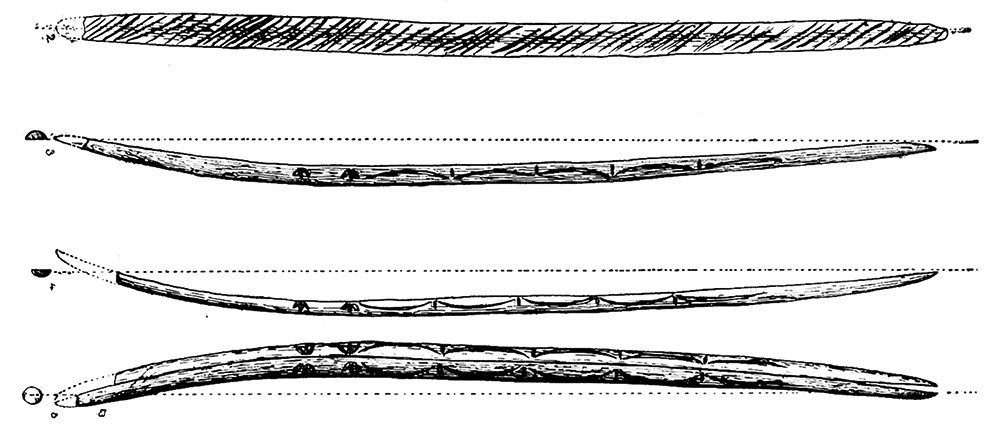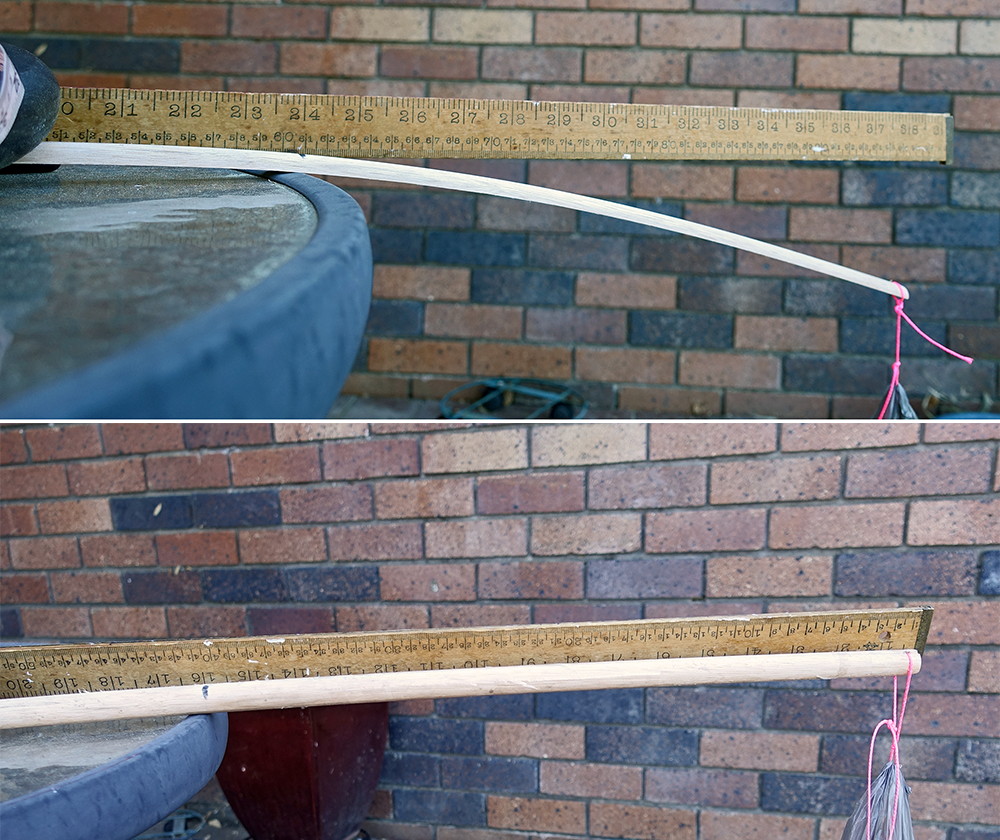Baguettes demi-rondes

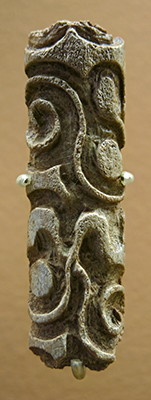
Magdalénien
(left and right) Engraved baguettes demi-rondes from Isturitz. These are spear tips or points formed of two half-cylindrical rods of bone or antler glued together, often with deeply incised decoration.
Note the wart-like projections on the left hand image, sometimes referred to as tubercles.
Photo: Don Hitchcock 2014, 2015
Source: Original, Musée d'Archeologie Nationale et Domaine, St-Germain-en-Laye
Text: Sacchi (2003)
Baguettes demi-rondes, known as ‘half-round rods’ (HRRs for short) in English, are a two-part composite projectile point technology usually manufactured from antler, though the occasional example made from bone or ivory has also been identified. In general, the HRR is made up of a pair of elongated plano-convex pieces which when fixed together (presumably in conjunction with a fixing agent) form a single whole with an oval section. While the distal (tip) end of the complete HRR point is cylindrical in section and designed for piercing as part of a spear point, the proximal (hafted) extremity may be of a number of different morphologies, including conical, bevelled, or fork-based.Text above: Langley et al. (2015)
This method of point construction allowed the Magdalenian toolmaker to construct a projectile point of much larger proportions than the physical constraints imposed by the raw material (that is, antler beams) usually allowed. Having been reported since the early 20th century, this weapon type has long been considered as a 'fossile directeur' for the Middle Magdalenian (18 700 BP to 15 800 cal. BP), though these artefacts are also known to appear (though in far less numbers) in early and late Magdalenian contexts . Recently, a number of HRRs from Isturitz were dated radiometrically with the dates falling between 17 100 - 15 800 cal. BP, confirming a late Middle Magdalenian attribution of this technology.
The term 'baguette demi-ronde' is unfamiliar and exotic sounding to most English speakers, but simply refers to a wooden strip used to cover joins in wall panelling. In English it is called 'half round rod', and is available from most hardware stores. Note that even for this purpose, this rod from a French supplier is not semi-circular, but has a width of 14 mm, but a depth of only 5 mm, not 7mm, which would be the dimension if it were semi-circular.
Photo: https://www.hubo.be/fr/p/baguette-demi-ronde-5x14-mm-240cm-bois-dur-blanc/6591.html
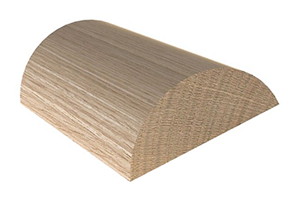
Half round rod from an Australian supplier, 30 mm by 12 mm.
Photo: https://www.porta.com.au/porta-product-type/half-round-dowel-tasmanian-oak/
Paired baguettes demi-rondes pieces from Isturitz.
The 'flat' surface is in reality almost always concave. It is much less carefully polished than the convex side, and it reveals some parts of the spongy matter which forms the interior of the reindeer antler.
( note that a concave surface would allow the 'glue line' to be very thin or non-existent, an important aesthetic consideration - Don )
The edges are slightly raised, and the middle, hollowed out as a shallow gutter, is marked by very irregular transverse streaks, made with a burin, without any pretense of keeping them parallel or equal, and which begin at one end and succeed each other, It should be noted that these striations are only the middle of the rod without reaching the edges.
The two pieces were found still side by side, as they had been when in use. Originally, the object would have been 370 to 380 mm in length, with the largest width being 12 mm in the middle of the pair of the perfectly matched baguettes, with a maximum thickness of 6 mm, decreasing towards the ends.
The two rods are, in most respects, identical and fit very well one on the other. Their convex faces are decorated with the same motifs, with the marked intention, not absolutely obtained, of achieving complete symmetry. The decorations, executed with a burin, are five in number and form two parallel patterns running along each side of the wand and petering out towards the ends.
Not only have the two pieces been made for each other, but almost certainly they were made on each other.
Once the two pieces were taken from the reindeer antler, possibly from alternate parts of the same reindeer antler, in order to obtain two profiles as similar as possible, the 'flat' faces were first ground flat, grooved, and then glued. Then began the exterior finishing which completely married them into an integral whole. Finally, the artist engraved the curious motifs that decorate their surface.
The question then arises, why were they made in two parts? The answer is easy, on reflection: reindeer antler, the material which is almost exclusively used, is composed of a hard external layer, relatively thin, and of a spongy and unconsolidated interior.
It is certainly because of the small thickness of the cortex that the Magdalenians were led to juxtapose two pieces, to obtain a greater strength and thickness, with two hard and durable faces which were, coincidentally, easy to decorate.
Photo and text: adapted from Passemard (1916).
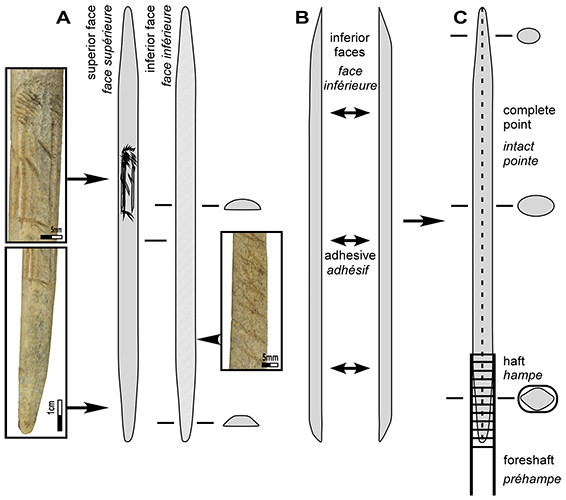
Baguettes demi-rondes composition with examples from the artefacts from Grotte de l’Abbé.
A. Details of the superior and inferior face of a HRR component.
B. Fixing of the two halves.
C. Morphology of a complete HRR point.
Photo and text: Langley et al. (2015)
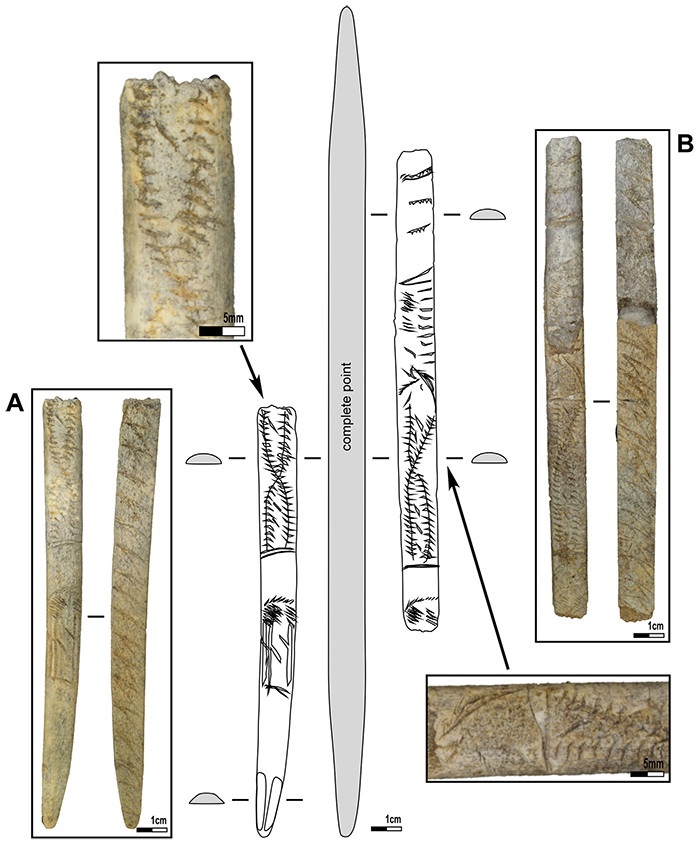
The paired Baguettes demi-rondes pieces.
A. Mesial-proximal fragment (GdA 20).
B. Mesial fragment (GdA 19).
Detail of engraved decorations in inset boxes.
( note that these are very important discoveries from Grotte de l’Abbé, and are only the second extant example of an original pair of baguettes demi-rondes, the other being from Isturitz (Passemard, 1916). They are, like the rubber 'flip-flops' or thong sandals found washed up on Australian beaches, almost inevitably found as singletons - Don )
Photo and text: Langley et al. (2015)
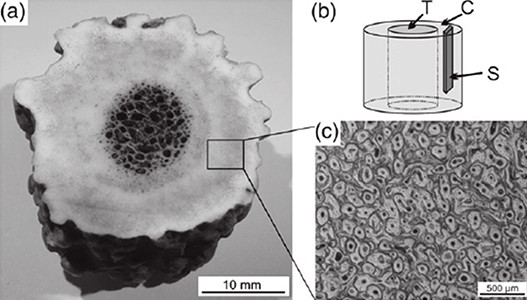
This cross section of a deer antler shows that more than one third of the diameter is taken up by the weak spongiosa, once we allow for smoothing of the outside surface.
By using just the cortex we can get a very much stronger, stiffer, and narrow spear head, ideal for the purpose.
Reindeer antler has a similar cross section, but the boundary between the spongiosa and the cortex is less well defined. Reindeer antler, however, has longer, straighter sections from which to cut material for baguettes demi-rondes.
Photo: Krauss et al. (2009)
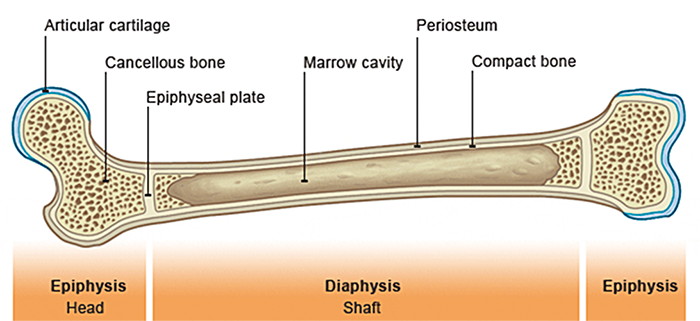
For bone, the only suitable material is a long bone such as a femur. Here, the need for lamination is much more critical.
In the section which is most likely to be used, there is a hollow section, the marrow cavity. It may well be that baguettes demi-rondes were first developed to make a tough, stiff spear head from bone, with the technique later being adapted for reindeer antler.
There are even baguettes demi-rondes made of mammoth ivory, which is a triumph of technique over the need for it - ivory can be chosen which is homogenous throughout its thickness and length.
Photo: http://www.bbc.co.uk/schools/gcsebitesize/pe/appliedanatomy/2_anatomy_skeleton_rev4.shtml
Why make Baguettes demi-rondes anyhow?
Because they are very much stiffer and stronger!
For this experiment, I went down to the local hardware store and got a length of half round rod. First I drilled a hole at one end, and marked a length of 38 cm, the length of the pair of baguettes demi-rondes from Isturitz, described by Passemard (1916), from the hole, along the length of the rod.
Then I attached a weight of two kilograms to a string through the hole, and measured the deflection, which was 90 mm, as shown in the upper photograph.
I then glued another piece of the rod to the first, and when it was dry I drilled through the original hole to complete the hole through the glued rods. The resulting rod was twice as thick as the original.
I then attached the same weight of two kilograms to the string through the hole, and measured the deflection, which was 8 mm, as shown in the lower photograph, though the deflection is so small that it is difficult to both measure and to capture in a photo.
This gives an eleven times increase in stiffness or strength to the glued rods. I would have expected it to be only eight times (23 by mechanical theory) for double the thickness, but perhaps the glue made the rod thicker than it would otherwise be, and in any case it is within the bounds of experimental error.
This method would thus have resulted in a very stiff and strong spear point, and like two ply yarn, any fault in one part is less likely to cause failure, since the accompanying section takes up the strain.
Photo: Don Hitchcock 2017
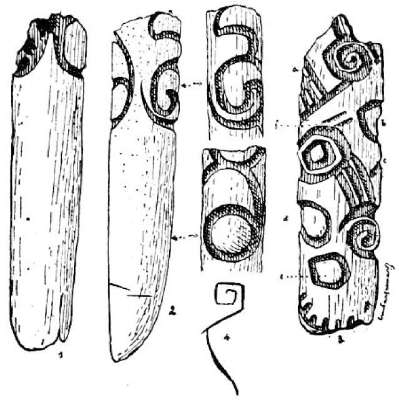
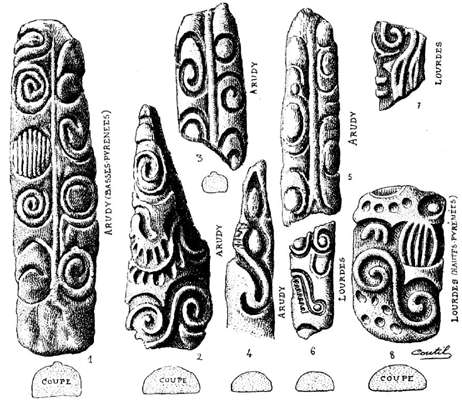
Magdalénien
(left) Spirals on baguettes demi-rondes found at Isturitz.
(right) For comparison, spirally decorated baguettes demi-rondes at Arudy in the Basses Pyrénées and at Lourdes, in the Hautes Pyrénées.
Note the cross sections.
Photo: Passemard (1920)
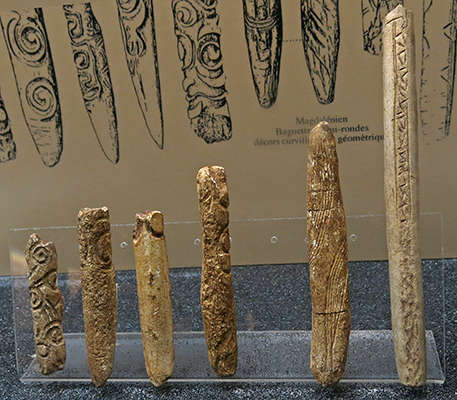
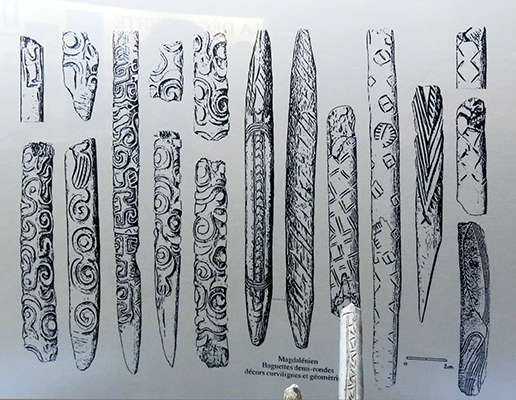
Magdalénien
Baguettes demi-rondes from Isturitz.
Photo: Don Hitchcock 2014
Source: Facsimile, display, Grottes d'Isturitz et Oxocelhaya
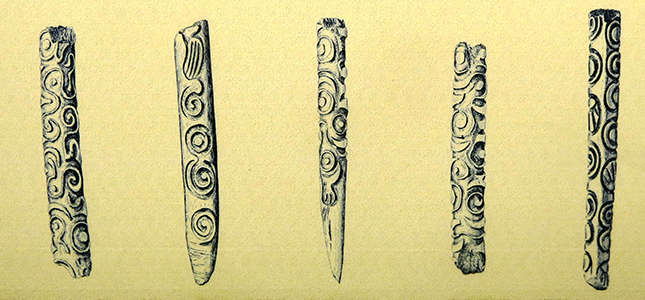
Magdalénien
Baguettes demi-rondes engraved in spirals are characteristic of the Grotte d'Isturitz.
Photo: Don Hitchcock 2014
Source: After E. and S. de Saint-Périer, from a display at the Musée d'Archeologie Nationale et Domaine, St-Germain-en-Laye
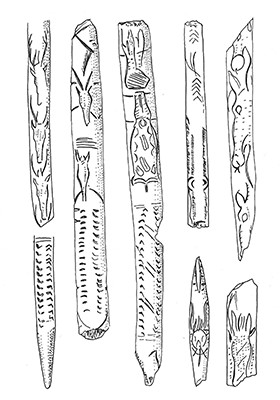
Decorations on baguettes demi-rondes from the layers of harpoons with a single row of barbs.
Photo: Breuil (1912)
Feruglio (1992) has very useful descriptions and drawings of various baguettes demi-rondes, including these observations:
The baguette demi-ronde is a piece of cervid (deer) antler or more rarely bone or ivory of generally plano-convex section. Two faces are distinguished: the upper or dorsal face, the most convex always constituted of the compact part of the wood and bearing the eventual decor.Text above: Feruglio (1992)
The face that is opposed to it is the lower side or the venereal side which can bear traces of spongiosa. In most cases it receives a striation.
( i.e it is the side which is prepared for glueing by putting random scratches on it to aid adhesion - Don )
The edges are sharp. The ends of the half-round rod are provided with arrangements of different types. ( i.e. one end is pointed, the other is carved or ground down so that it can be more easily attached to a shaft - Don )
Raw material
The baguettes demi-rondes discussed here are essentially made of male deer antler, rarely of bone, more rarely of ivory (note that ivory is a material which cleaves by ageing, a spear can thus easily become a 'baguette demi ronde').
( if that happened, you would expect the two pieces to be found together, I would have thought - but it is a fact worth knowing. And really, there is not a lot of point in making ivory baguettes demi-rondes from ivory, since there is no spongiosa in ivory, and perfectly good points can be made with no preparation apart from carving them from the tusk - Don )
Sites from which deer baguettes demi-rondes came from for the purposes of this paper:
Two sites: Enlene (Ariege) and Isturitz (Pyrenees-Atlantiques).
- Enlene: Museum of Pujol Ii Montesquieu-Avantes (Ariege). Collection of Begouen, series from the middle Magdalenien, 432 pieces in total.
- Isturitz: Museum of National Antiquities at Saint-Germain-en-Laye.
Passemard Collection (206 Pieces) and Saint-Perier collection (200 pieces) except for the Saint-Martin room.
The stratigraphy is that established by E. Passemard and R. de Saint-Perier.

Ends of baguettes demi-rondes:
1: Pointing blunt or pointed, cross section round or semi-circular.
2: thinned base.
3: gutter or groove on the upper side.
4: gutter or groove on the underside.
5: lateral bevel.
6: shortened base.
7: forked.
Photo and text: Feruglio (1992)
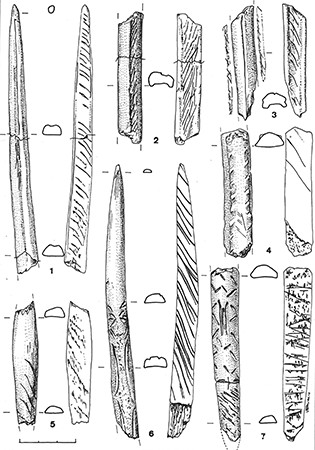
Baguettes demi-rondes from Isturitz:
I: Longitudinal axial groove without scratches
2: longitudinal axial groove, scratched
3: side grooves
4: tubers, wart-like projections
5: deep scratches
6: parentheses and clover leaves
7: various
Photo and text: Feruglio (1992)
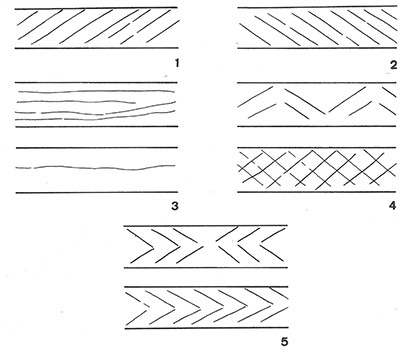
Scratch patterns on the 'flat' surfaces of the baguettes demi-rondes from Isturitz.
1: oblique scratches ascending from right to left.
2: oblique scratches ascending from left to right.
3: longitudinal scratches.
4: alternating scratches, sometimes in a cross hatch pattern.
5: chevron patterned scratches.
Photo and text: Feruglio (1992)
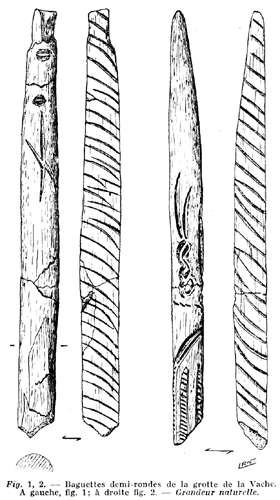
Baguettes demi-rondes from the Grotte de la Vache.
Note the carved decorations on the convex side, and the oblique grooves on the planar or slightly concave side to aid adhesion.
The baguette demi-ronde on the right has what appears to be a stylised Ibex head carved into it.
Photo: Breuil et Robert (1951)
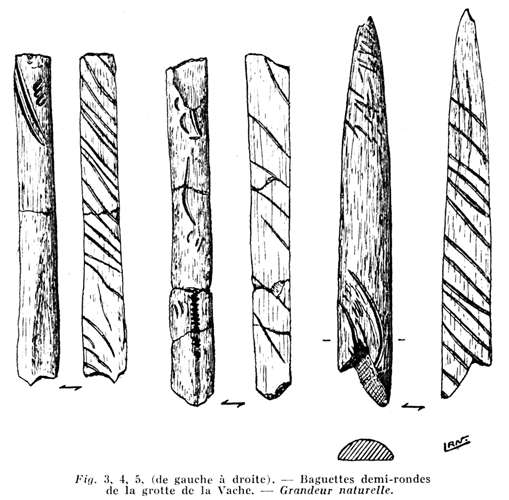
Baguettes demi-rondes from the Grotte de la Vache.
Photo: Breuil et Robert (1951)

Baguettes demi-rondes from the Grotte de la Vache.
Photo: Breuil et Robert (1951)

Broken bone rod from La Madeleine engraved with the head of a bear facing a complex phallic form. Upper Magdalenian.
Photo and text: Marshack (1972)

This baguette demi-ronde is possibly one half of a projectile point that together with another similar one would form a specific point - a baguette demi-ronde. - Middle Magdalenian.
(The carvings on this piece are surreal - it includes what looks like a bear's head and a double phallus - Don )
Photo: Don Hitchcock 2008
Source: Original on display at Le Musée National de Préhistoire, Les Eyzies-de-Tayac
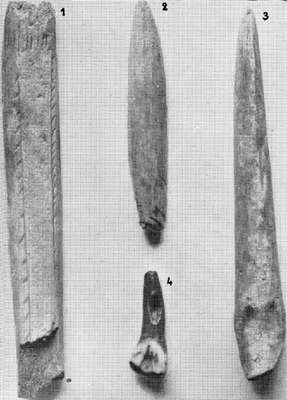
From Robert (1943) we get this (translated) description of the discovery of the objects pictured at left:
The improvements for industry made to the area in question, and the leveling of the floor of La Grotte de Bédeilhac, have left only narrow strips against the wall where archaeological layers remain.
Together with the remains of a fireplace located about 100 meters from the entrance, on the right of the main gallery, we found, in an area 150 cm long and 6 cm wide, completely encased in calcite:
3 cores, a chisel, a discoid scraper; a scraper point, a scraper-burin, two retouched truncated blades, 4 retouched flakes, and a superb burin of 8 cm long in sandstone.
The bone material includes a fragment of a smoother, and, shown in the photograph:
1 - a fragment, 10 cm long, of a baguette demi-ronde decorated with two side bands of lines and eight parallel lines at one end.
2 - the point of a spear
3 - a triangular sectioned point whose base has been broken
4 - a drilled bovine tooth
Photo: after Robert (1943), in Beltrán et al. (1967)
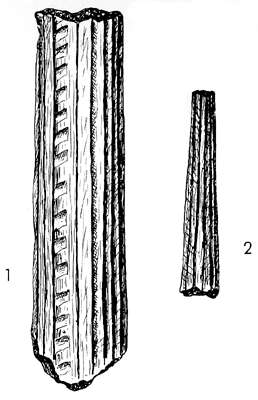
Bone industry of la Grotte de Bédeilhac:
1 Fragment of a baguette demi-ronde.
2 Spear point.
Photo and translated text: after Robert (1946), in Beltrán et al. (1967)

Bone industry of la grotte de Bédeilhac:
1 Baguette demi-ronde in the process of being made
2 Decorated spear point
3 Tool handle
Photo and translated text: after Robert (1946), in Beltrán et al. (1967)

Baguette demi-ronde from Laugerie Basse.
Half round rod, made from reindeer antler. Plano-convex cross-section tapering to rounded tips at both ends. At one end the point is formed by a bevel on each side, scored with deeply incised, multiple striations. This end is rectangular in cross-section whereas the opposite end tapers to a plano-convex tip.
The central area of the convex face is decorated by the alternate removal of patches of antler to leave a raised mid-line with low relief nodules on either side. The flat face is decorated by irregularly spaced, transverse incised lines which are more numerous in the central section than on the tapering areas.
Length 123 mm, width 18 mm, thickness 8 mm.
Catalog: Laugerie Basse, Palart.208, excavated by Christy and Lartet in 1863.
Photo and text: © Trustees of the British Museum, CC BY-NC-SA 4.0
Source: Original, British Museum
Baguette demi-ronde from Laugerie Basse.
Antler half rod, plano-convex in section and nearly complete, except for an ancient break at the tip. Obverse surface decorated at the base with a group of longitudinal lines, at the tip with diagonal striations and in the centre with a double engraved line flanked on each side by a row of diagonally-cut pimples. Reverse engraved with two opposing series of chevrons, one of which has a central incision.
Length 206 mm, width 17 mm, thickness 5 mm.
Catalog: Laugerie Basse, Palart.209, excavated by Christy and Lartet in 1863.
Photo and text: © Trustees of the British Museum, CC BY-NC-SA 4.0
Source: Original, British Museum

Baguette demi-ronde from La Madeleine.
Photo: Don Hitchcock 2015
Source: Original, Musée d'Archeologie Nationale et Domaine, St-Germain-en-Laye
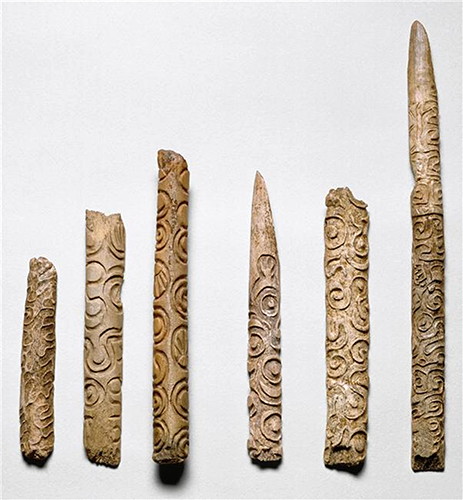
Baguettes demi-rondes from Isturitz.
Photo: © RMN-Grand Palais, Musée d'Archeologie Nationale et Domaine, St-Germain-en-Laye
Source: Original, Musée d'Archeologie Nationale et Domaine, St-Germain-en-Laye
References
- Beltrán, A., Robert, R., Gailli R., 1967: La Cueva de Bédeilhac, Zaragoza 1967
- Breuil, H., 1912: Les subdivisions du Paleolithique superieur et leurs significations, Congres Internat. d'Anthrop. et d'Arch. prehistorique., XIVeme session, Geneve, p. 165-238
- Breuil, H., Robert R., 1951: Les baguettes demi-rondes de la grotte de la Vache (Ariège), Bulletin de la Société préhistorique française, 1951, tome 48, No. 9-10. pp. 453-457
- Feruglio, V., 1992: Fiches Baguettes demi-rondes, Fiches typologiques de l'industrie osseuse préhistorique, Cahier V, bâtons percés, baguettes, Edition: éditions du Cedarc, Treignes, Chapter: 2.1. Fiche baguettes demi-rondes, Editors: H. Camps-Fabrer, pp.71-83
- Krauss, S. et al., 2009: Inhomogeneous fibril stretching in antler starts after macroscopic yielding: Indication for a nanoscale toughening mechanism, Bone ,Volume 44, Issue 6, June 2009, Pages 1105-1110
- Langley, M. et al., 2015: A Magdalenian decorated baguette demi-ronde from Grotte de l’Abbé (Charente, France), C. R. Palevol (2015), http://dx.doi.org/10.1016/j.crpv.2015.01.009
- Robert, R., 1943: Nouvelles fouilles à Bédeilhac, Bulletin de la Société préhistorique française, 1943, tome 40, No.10-12, pp. 276-281
- Robert, R., 1946: Fouilles à la grotte de Bédeilhac, Bulletin de la Société préhistorique française, 1946, tome 43, No. 9-12. pp. 322-326
- Passemard, E., 1913: Fouilles à Isturitz (Basses-Pyrénées), Bulletin de la Société préhistorique française, 1913, tome 10, N. 11. pp. 647-649.
- Passemard, E., 1916: Sur les Baguettes demi-rondes, Bulletin de la Société préhistorique de France, tome 13, n°6, 1916. pp. 301-307; doi : 10.3406/bspf.1916.7379 http://www.persee.fr/doc/bspf_0249-7638_1916_num_13_6_7379
- Passemard, E., 1918: Les sculptures pariétales de la caverne d'Isturitz, Bulletin de la Société préhistorique française, 1918, 15, 466–467
- Passemard, E., 1920: Les Spirales de la caverne d'Isturitz, Bulletin de la Société préhistorique française, 1920, tome 17, N. 6. pp. 150-154.
- Passemard, E., 1920b: Une gravure de lièvre d'Isturitz, Bulletin de la Société préhistorique française, 1920, tome 17, N. 3. pp. 79-81.
- Passemard, E., 1944: La caverne d'Isturitz en Pays Basque, Préhistoire, 1944, 9, 7–95
- Sacchi, D., 2003: Engraved Magdalenian plaquettes: a regional and stylistic analysis of stone, bone and antler plaquettes from Upper Palaeolithic sites in France and Cantabric Spain, Oxford: British Archaeological Reports (International Series) 369
Back to Don's Maps
 Back to Archaeological Sites
Back to Archaeological Sites

